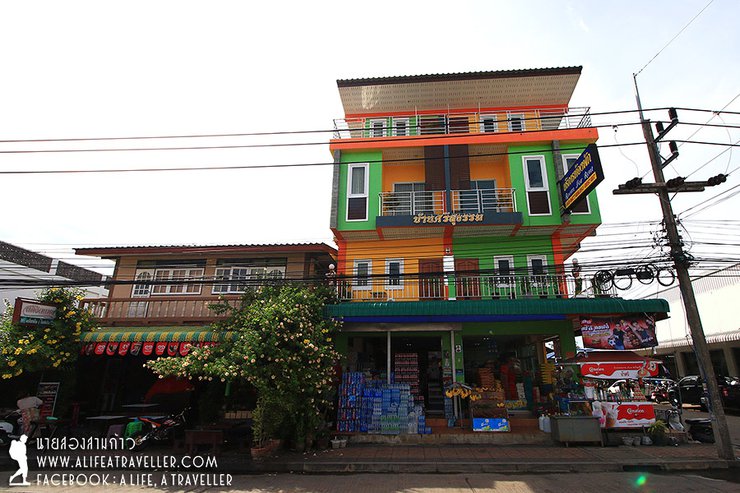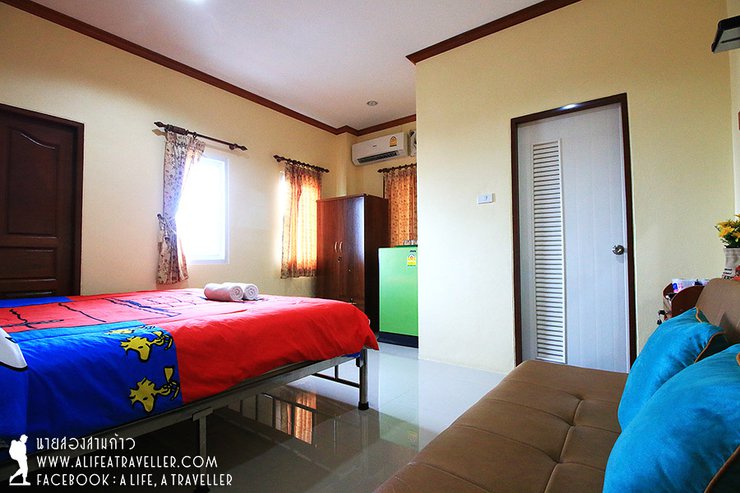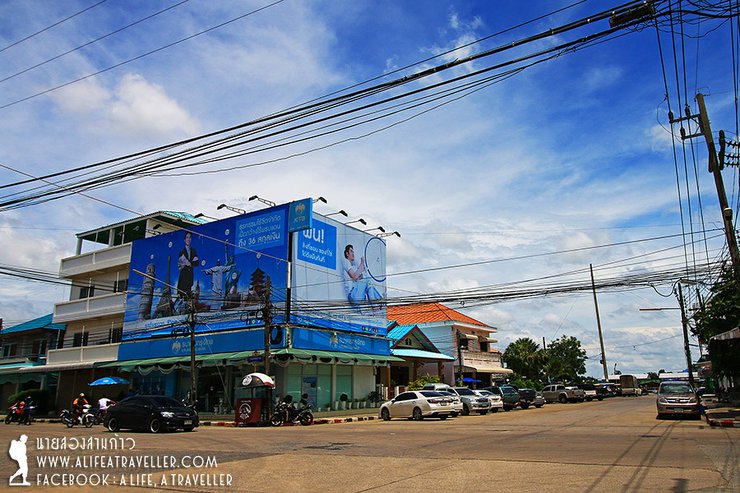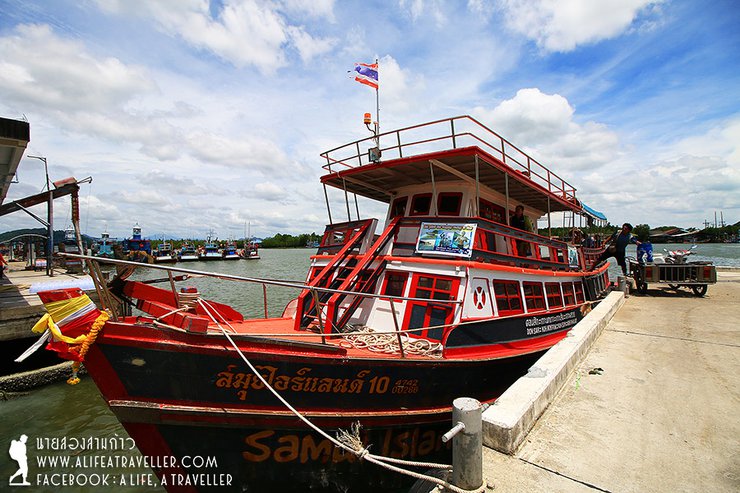Where is Phaluai Island? I'm a native of Surat Thani, and I've never heard of it... This is the response I often receive when I mention my backpacking trip to Phaluai Island. The primary reason for its obscurity is likely that the island is not a tourist destination. It has no reputation for tourism and is unlikely to develop in that direction.
I learned about Koh Paluay four or five years ago when I visited the Ang Thong National Marine Park. I spoke with a park ranger who told me about the island, but I never had the chance to visit it. Then, last May, I happened to be participating in an activity to explore community tourism in Surat Thani (read the review > http://wp.me/p7ca93-1tO). So, I took the opportunity to stay longer and visit Koh Paluay.
Koh Phaluai is the fourth largest island among the 108 islands of Surat Thani. It is part of the Ang Thong National Marine Park, but only half of the island is within the park boundaries. The other half is inhabited by a local community. Administratively, the island belongs to Koh Samui district. Most of the islanders are fishermen or rubber plantation workers. Koh Phaluai is known as a "clean island" or "clean energy island" because it is a model for using renewable energy sources such as wind turbines and solar cells.

To reach the island, you must take a boat from the Don Sak District Market (the market pier, not the ferry pier to Koh Samui). Boats depart daily at 1:00 PM, with two operators alternating on even and odd days. The fare is 150 baht, and the journey takes approximately two hours, offering scenic views. While the distance is not significant, the boat travels slowly.
What will the top of the island be like? Let's go and see.
(1)
This trip to Phaluai started from Surat Thani city. The easiest way to get to Don Sak Market is by taking a minivan from Surat Thani to Don Sak. The minivan stand is located at the Talat Kaset 2 market and costs 70 baht. Make sure to board the minivan at the Talat Kaset 2 market and not from the tour agency that takes you to the Koh Samui ferry pier. The price at the pier is 150 baht, which is specifically targeted at tourists.
The road was clear and there was no traffic. I arrived at the Don Sak district market in the late afternoon. From the initial information I had received, I knew that the boat to Phaluai only operated on even days, so I was not in a hurry because today was an odd day. However, when I asked people around the market, I found out that there were boats on both even and odd days, but they departed from different piers. Oh... I missed a day because of that. The boat had already left.
Never mind, I'm always running late anyway. Let's find a place to stay. There are a couple of places near the market, but this one caught my eye the most. Baan Srisutham, it's like an apartment with both daily and monthly rates. It's located near the van queue, 500 baht per night. The room is new, clean, and easy to find food. There's a 7-Eleven and Lotus within walking distance. They also have bicycles for rent to explore the area.


The next day, the boat departs at 1 pm. Pack your bags and check out around noon to avoid waiting. At the large intersection in the market, walk to the end of the alley. This is the pier for departures on odd-numbered days.

The pier is about 500 meters away, located in this alley. Once you arrive, purchase a 150 baht ticket. Almost all users are from Koh Phayam.


The difference between even and odd-numbered boats is not only that they dock at different piers, but also that they land at different bays on the island. Odd-numbered boats land at Bay Three, while even-numbered boats land at Bay Two (Phaluai Island has four bays, simply called Bay One, Bay Two, Bay Three, and Bay Four). Landing at Bay Two is much more convenient.
The boat departed from the shore around 1 pm under pleasant weather conditions. However, as it approached Koh Paluway, the sky darkened significantly. Despite the ominous appearance, it did not rain. Strong winds blew the rain clouds away.


The boat braved the waves and arrived at Koh Paluay shortly before three in the afternoon. The first glimpse at the pier made it clear that this was not a tourist island at all. There were no buses, no taxis, no motorbike taxis. As people disembarked, cars arrived to pick them up, leaving in groups of two or three. In no time, the pier was quiet again.


After inquiring about accommodation from locals near the pier, I learned that there are only a few options available on the island. Turning right at the Aow Song Pier intersection leads to resort-style accommodations, while continuing straight offers homestays for 500 baht per night. Needless to say, I chose the more affordable option. (Laughter...)
At the intersection near the port, there are many signs about the renewable energy project.

At the intersection, a quick glance reveals the homestay in question, named "Paluai Homestay." The front of the building houses a convenience store and a made-to-order food stall. Technically, the term "homestay" may not be entirely accurate; "bungalow" or "guesthouse" would be more appropriate descriptions.
We agreed on a simple deal: no payment upfront and no need to show our IDs, since we were stuck on the island anyway (laughs). The bungalow had a balcony where we could sit and enjoy the breeze and the distant sea view. The atmosphere was peaceful and quiet. The bathroom was small, with cloudy groundwater, and electricity was only available from six in the evening to early morning. But none of that was a problem for me. It was perfectly fine.



The image depicts a wind turbine used for electricity generation. Additionally, each household is equipped with solar panels. Based on discussions, the government provides one set of wind turbines and solar panels per household. Residents who desire additional units can purchase them.

Today, I am not in a hurry because the weather invites me to be lazy and roll around in my room. It's been a long time since I've been able to live a simple life, without having to pick up my camera to take pictures. It's truly relaxing...
(2)
A comfortable sleep with a slightly late wake-up, a full night's rest, and a refreshing breeze. Staying in a bungalow for 500 baht a night, I didn't expect breakfast to be included. It turned out that this set was waiting for me on the balcony. What a wonderful surprise!

A flock of seven or eight hornbills flew past the balcony, causing me to nearly spill my coffee. I managed to grab my camera and take a few photos, even though they weren't very clear. The presence of hornbills, which are easy to spot, indicates that Koh Palue is truly abundant in nature.


Today, I decided to explore the island on a rented motorbike. The accommodation offered rentals for 200 baht per day. The motorbike was well-worn but ready for adventure. The island has only one main road, so there's no need to worry about getting lost or using a map. The road winds its way from Ao 1 in a semicircle, passing Ao 2 and ending at Ao 3. Ao 4 is located within the Mu Ko Ang Thong National Park and can only be reached on foot.
I opted for Cove One first, simply because of its name (haha...). The road leading there was as expected, a cloud of red dust. Luckily, I had a bandana to cover my mouth and nose.

Every house on the island has a vibrant green windmill, but the term "house" on Koh Phluay is a loose one. The houses are scattered far apart, with only about a hundred households on the entire island. The official population is four hundred, but the actual number of residents is likely lower.


The motorcyclist continued riding until they reached a dead end. They then turned around and rode back.

Turning into the alleyway, we find ourselves facing the open sea. This is the state of Ao No. 1 during low tide. There is no beach, no sand, just an almost entirely muddy seabed. In some places, rocks have been placed to create channels for boats to navigate (these were not built by the locals, as doing so would be illegal; the Marine Department is the agency responsible for this). Scattered around are small huts belonging to the seafaring community. The scene can only be described as utterly raw.



After taking some photos, we rode a little further and came across some villagers who were collecting their fishing nets. We stopped to chat with them for a while. As I mentioned earlier, the main occupation of the people in Phaluai is fishing. The shrimp, shellfish, crabs, and fish they catch are taken by boat to be sold at the Donsak market. It's a remarkably simple life.




One regrettable observation was the large number of small fish and crustaceans caught in the nets. These included crabs and small mantis shrimps, which were discarded. Some of the fish were of low value or too small, and they were simply thrown back into the water to die. While these fish are edible, their abundance and the locals' familiarity with them have led to a lack of interest in consuming them.



I understand your point. It's true that people from different backgrounds have different experiences and perspectives. City dwellers, for example, are accustomed to paying for goods and services, while rural residents often rely on natural resources for sustenance. These differences in environment and lifestyle shape how people think and what they value.
Let's take a break from serious matters to avoid stress and continue our journey.
From one bay to the next, passing by Ang Thong Beach Resort, I decided to stop by for a quick visit. Wow, this place is truly amazing! The rooms are top-notch, costing 1,200 baht per night. The private beach is serene and lush. While it might not be worth it for a solo backpacker, if you're looking for a romantic getaway with your sweetheart, the ambiance is definitely worth the price. (Haha...)


A short drive will take you to Ao Song, where you can park by the roadside and take some photos. The towering limestone mountains you see are Khao Pha Ta Siam, considered the sacred guardian spirits of Koh Phaluai. There are actually three peaks: Ta Siam, Ta Sak, and Ta Saeng.

A short distance from the beach is Koh Paluai Eco Resort, which costs 900 baht per night. If two people stay in a room, an additional 200 baht per person will be charged. According to inquiries, camping is permitted here. It is the first resort on Koh Paluai, owned by the former director of Koh Paluai School, Mr. Praphon.



While visiting Eco Resort, I discovered a scenic viewpoint established by teacher Pheeraphon on a hilltop. The viewpoint offers panoramic views and is located between Ao 2 and Ao 3. A large sign indicates the location, but the road leading to it is challenging. Typically, four-wheel drive vehicles are used to navigate the terrain. I would rate the difficulty of riding a motorcycle up the hill as 9/10, partly due to the recent continuous rainfall that has made the path muddy and slippery.
Despite the slightly overcast sky, the panoramic views from the top were truly breathtaking. The observation point was well-maintained, offering a clear vista of the surrounding landscape. Looking towards the horizon, one could see the distant shores of Koh Chueak Island, where a small community of seafaring people resided.


The other side is a corner that looks out from the third bay, and the three limestone peaks that are lined up are the three Khao Pha Ta.



The sign at the entrance states an entrance fee of 30 baht for Thai citizens and 50 baht for foreigners. However, upon my arrival, there was no one present to collect the fee, so I entered free of charge.
After a challenging descent from the viewpoint, we continued to Ao Sam, which resembles Ao Nuea but boasts a larger mangrove forest. This bay is where boats carrying visitors arriving on odd-numbered days dock. As there are no accommodations in this area, as mentioned earlier, it is more convenient to travel by boat on even-numbered days.



A newly planted mangrove forest in a secluded bay cove, with the hope that it will thrive and become a thriving ecosystem.


The road ends here, with a single farmhouse in sight. I spoke with the owner, an elderly woman who is a native of Koh Phluay. She shared that the island used to be much more vibrant, but due to hardships, younger generations have moved away, leaving many abandoned gardens. The remaining residents are primarily seafaring people. The woman herself owns a farm in Chumphon and only returns to Koh Phluay a few times a year.
Engaging with local people in this way has significantly enhanced our understanding of the area and its history.
To reach Ao Si, a hike is required as it is located within a national park. The trail is not overly challenging, with some gentle inclines and declines. The path is well-defined, and the estimated distance is around one kilometer. The hike takes approximately 15-20 minutes at a leisurely pace.


And what was found beyond the forest line was... a breathtakingly beautiful beach. Its beauty was unparalleled, truly magnificent and awe-inspiring.



There is enough time for a short walk. I give this beach bend a perfect score of ten for its natural beauty. The only downside is the litter and lack of cleanliness, which is typical of islands like this. The garbage is carried by the wind and water, and with so few people on the island, who is going to clean it up? This area is uninhabited and not a tourist destination.
From Ao Si Bay, you can see Ko Wua Talap, the location of the park headquarters, and the famous Pha Chan Jaras.

Wading across the sandbar, the water barely reaching my ankles, I spotted the small seafaring village of Ao Si in the distance.



As dusk approached, I hurried back, despite the breathtaking sunset over the fourth bay. I was mindful of being alone and the potential dangers of returning after dark. Instead, I opted to capture the sunset at the third bay, where I encountered two other tourists who had arrived on the same boat the previous day. They were staying at Ang Thong Beach Resort, making us the only three tourists on Phaluai Island.


(3)
Although you may want to stay longer, the day is over. The boat arrives at Phluang only once a day and must depart at the same time. Both even and odd day boats depart from the island at 7:00 AM. In terms of travel planning, regardless of how many days you stay or where you stay, it is best to arrange your schedule to stay at Phluang Homestay on even days for the last day.
The boat departs at seven o'clock. It's just a two-minute walk, so why the rush? But at 5:40 am, when the sky was still dark, there was a knock on my door. "Young man, the boat leaves at six this morning. We're running low on fuel, so we can't be late," the caretaker said.
The situation was urgent, leaving no time for brushing teeth or showering. With belongings hastily stuffed into backpacks, they rushed out of the room. Despite the frantic pace, the aunt remained calm, offering a reassuring smile and a cup of coffee. The departure was unexpected, with the boat crew only recently informing houses of the earlier departure time. It would likely take some time for everyone to arrive at the port.
Why the rush?

The boats are full of fresh seafood to be sold at Donsak Market, including crabs, mantis shrimps, prawns, fish, and squid. A local villager said that the amount of seafood is actually less than usual, as the recent unpredictable weather has prevented many boats from going out to sea. Normally, the catch is much larger.



The boat finally departed from the pier at 6:30 PM. It was a funny scene, reflecting the simple, rustic charm of Koh Phayam. While I hesitate to call it a tourist destination, I would recommend it to anyone who enjoys a raw, unpolished experience.
The photo you see was taken in May, during a period of bad weather. Strong winds pushed debris towards the shore, making the beach appear dirtier than usual. In reality, the most beautiful time to visit the beaches of Surat Thani is between February and April. This is why I plan to return to Phaluai during this period. I am confident that the next photo of Phaluai will be vastly different from the one you see now.
Before embarking on your adventure to Koh Paluay, here are some essential details to keep in mind:
Ferry Schedule:
- Daily ferries depart from Donsak Market, alternating between even and odd-numbered days.
- Even-numbered days: Ferry departs from Ao Song Pier.
- Odd-numbered days: Ferry departs from Ao Sam Pier.
- Departure time from Donsak: 13:00
- Departure time from Koh Paluay: 7:00
- Important: Due to the local nature of the ferries, schedules may change without prior notice. It is highly recommended to call ahead and confirm ferry availability:
- Even-numbered days: 091-705-5598, 089-971-4832
- Odd-numbered days: 084-839-4160
Accommodation:
- Koh Paluay offers three accommodation options:
- Angthong Beach Resort (Ao Nueng): 1,200 THB per night, contact 085-150-2521
- Koh Paluay Eco Beach Resort (Ao Song): 900 THB per night, contact 093-637-2282, 095-083-9277
- Paluay Homestay (near Ao Song Pier): 500 THB per night, contact 097-135-1722, 089-292-1103
- Advance booking is strongly advised due to limited accommodation options and frequent visits by study groups or government officials.
Transportation:
- Motorbike rentals are available on the island for 200 THB per day.
Island Activities:
- Boat trips to nearby islands like Koh Angthong and Koh Wua Talap can be arranged through your accommodation. Expect to pay around 3,500 THB for a full-day trip with a maximum of 8 passengers.
- Other activities like fishing and squid jigging can be inquired about on the island.
- Consider exploring nearby islands like Koh Chueak and Koh Som by long-tail boat.
Best Time to Visit:
- The optimal time to visit Koh Paluay and the surrounding waters is between February and April.
- The monsoon season typically occurs from October to December.
Follow my travel adventures on another channel.
http://www.facebook.com/alifeatraveller
นายสองสามก้าว / A Life, A Traveller
Tuesday, October 8, 2024 11:18 AM



















